
From the outside, my favourite Chinese place is – how can I put this – a sketchy proposition at best. Its facade hasn’t seen a lick of paint since the Dulux sheepdog was a weaning pup, and the tatty menus speak of times when coconut oil was still considered a viable alternative to sunscreen.
But to sample its kung-po pork or its chicken and chive dumplings, served with a smile, piping hot and overflowing with an innate richness, speaks of more than just foodstuffs thrown together for profit. That’s why we return again and again.
The fact that it remains incredibly affordable is an undeniable part of its latent charms.
Now, rolling back into the pitlane of Wakefield Park after just a tantalising taste of Hyundai’s newest N, I’m feeling an undeniably similar affection for the little Hyundai i20 N. It’s nicely spiced, just hot enough, keenly priced, and hits the spot in exactly the right way.
I didn’t even know I’d be driving it, either, which made this brief but sweet treat even more delicious. Officially, I’m here to try the i30 N DCT, but luck and happenstance have made 2020 just a little bit less sucky today.
The i20 N sitting in the pit lane is a (very) recent arrival, having rolled out of the belly of a cargo jet just days before our drive, and sourced from Hyundai’s quality engineering team based at the company’s enormous testing facility in Namyang, about two hours from Seoul.
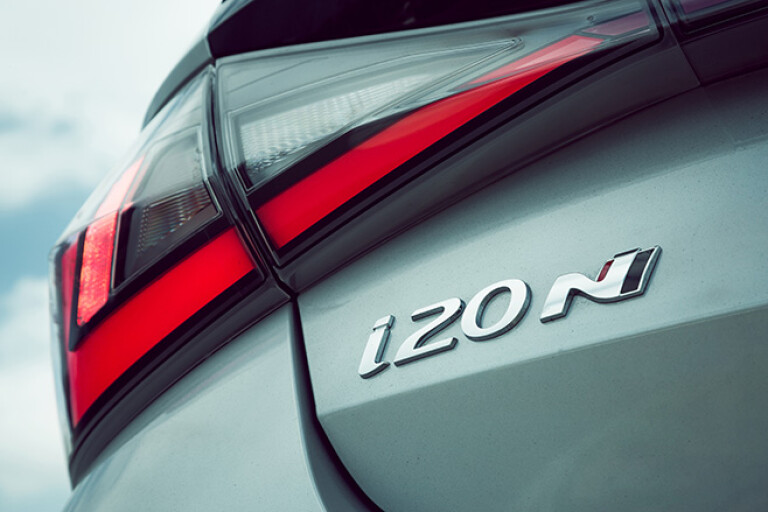
Hyundai calls it a ‘P stage’ prototype car, which is very close to the finished product – though local engineers will continue to beat it senseless and emails will continue to fly back and forth right up until the moment the lever for full production is pulled in early 2021.
“It was sent to Australia for what is called ‘total vehicle evaluation’,” we’re told. “It’s a series of road and track sessions to check areas like NVH, on-road characteristics, engine response, ergonomics, driveability, and track performance with a professional driver.” Sounds like a pretty cool gig…
To understand the i20 N is to know its older, bigger brother. When it dropped in 2017, the i30 N made waves. Instantly.
Here was a hot hatch that took the civility of a hot hatch, shook it around like a Rottweiler with a chew toy and threw it bodily over a precipice.
The i30 N was – and still is – a bloody hilarious thing, with a genuine edge and depth of talent I hadn’t experienced in a hot hatch since the front-drive Ford Focus RS of the early 2000s.
Its deliberately obnoxious exhaust, its sheer pace and its mischievous disdain for convention have brought Hyundai a legion of fans for its fledgling performance brand, let by the gruff but twinkling Albert Biermann, famed for his helmsmanship of the most famous single-letter performance brand of them all, BMW’s M.
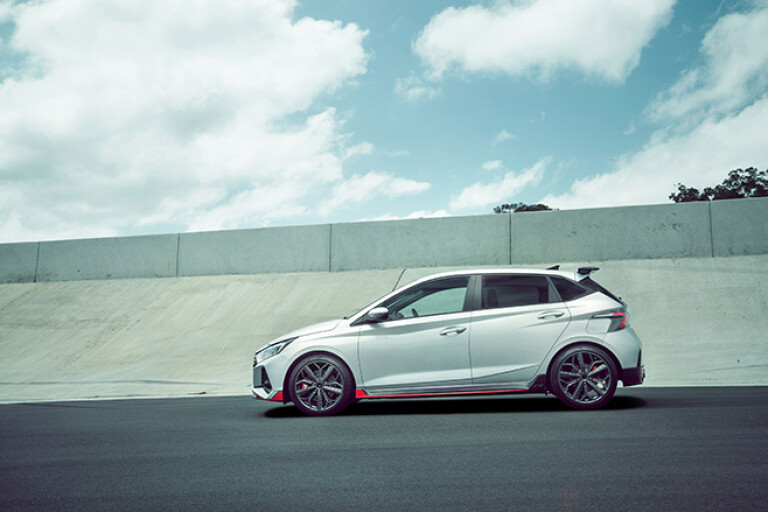
“Every time I see an i30 N, I see someone who’s chosen a manual,” remarked my 18-year-old son recently, right before he forgot to empty the damn dishwasher again. “I see an enthusiast.”
And he’s right. Hyundai is selling about 1000 i30 Ns a year, and without an auto on offer. There are already N clubs and N days, and Hyundai’s working on numerous N accessories and N upgrades.
At $41,000 and change, the i30 N isn’t exactly dear…but it isn’t cheap, either, and the incoming dual-clutch-equipped car will only push it further up the tree.
That is, ladies and gentleman, where the i20 N comes in.
What is the Hyundai i20 N?
Based on the Europe-only i20 five-seat, five-door hatch, the i20 N follows the i30 N playbook to the letter… but it offers a unique spin that not only makes the car more affordable – no prices yet, but let’s guess around $32,500 – but gives it a distinctly different character to its bigger, older brother.
“We really wanted to follow our three pillars; it’s an everyday sports car, it’s race-track capable, and it’s a corner rascal,” Klaus Koster tells Wheels over a video call.
Koster is head of Hyundai’s high-performance vehicle development, on site in Russelsheim, Germany, at the COVID-delayed launch of the civilian-spec i20. “Mr Beirmann keeps on telling us, ‘Guys, it’s all about the customer having fun.’
“This is important, and, for an engineer, sometimes maybe very challenging, because ‘fun’ is not so easy to measure. How do you measure? With the grin? How high is the blood pressure?”
To read the ingredients on the tin, though, you’d be forgiven for stifling a yawn and rifling over a few more pages.
A strut front end with a torsion beam out back. The same 1.6-litre turbocharged four-cylinder you’d find in a Kona or Tucson. Sliding brake calipers. Not exactly WRC-aping, tarmac-shredding specs.
It’s the parts you don’t see listed on the spec sheet, though, that provide the secret sauce, that extra punch to the i20 N’s delivery.

Take the body-in-white, for example. Plucking bodyshells off the production line of a mass-market B-segment hatch is not conducive to affordability, but Koster says he’s happy with the changes he’s managed to work into the regulation-issue platform, pointing out Hyundai actually makes its own steel.
“The base i20 is already a very good starting point for it, with a very solid body-in-white stiffness, but there’s nothing that cannot be improved,” he says.
“The body-in-white got some additional welding points similar to the i30 N and some reinforcement parts in the area behind the front wheels and towards the front sub-frame. So, there are some reinforcement parts inside that help to improve the initial steering response on the car but, yes, it was a very good basis.”
Sachs dampers are used at all four corners, tuned to a fixed rate after thousands of kilometres at Germany’s famed Nurburgring Nordschleife circuit.
A mechanical limited slip diff nestles between the front wheels. While the dampers are tuned particularly to suit the i20 N, it’s not been a matter of throwing mega-dollars at each corner, reckons Koster.
Eighteen models in 18 months as Hyundai overhauls its fleet
“What we were trying to is with Sachs, in this case, or with the supplier, is to have a very good damper tuning,” he explains, “but it’s a conventional damper. It’s not that we said ‘oh, this is the very special conventional damper’.”
And while the COVID situation has put a… damper on things (here all week!), there’s still a bit of Down Under down under the i20 N.
“We always involve the colleagues from Australia,” says Koster. “We had Andrew [Tuatahi, Hyundai Australia’s product manager] at the Nurburgring a few times. Unfortunately now, with all the situation of COVID-19, it’s not possible in this way, but I think we got a good alignment.”
Its 18-inch rims are shod in N-spec 215/40 R18 Pirelli P-Zero tyres, and those humble sliding calipers come from a car half a size larger again that the i20 N, clamping down on 320mm brake rotors that will have the under-braked Ford Fiesta ST surreptitiously tugging its tee shirt down in front of its jeans.
The i20 N comes with a six-speed manual gearbox and no other, while it still offers an N mode paddle, it eschews many of the complexities of the i30 N.
There’s a simple screen that acts as the dash, a larger multimedia set-up sitting proud of the dash and a handful of climate controls below it. The seat is slung low, the wheel feels slightly smaller than that in the i30 N and the three pedals are well placed should you wish to turn off the rev-matching function and keep old traditions alive.

In terms of eyeing rivals, Koster says Hyundai “looked at competitor cars, but then took our own way. We are not trying to copy a car which is on the market.
“Take the i30 N; we don’t want to make a second Golf GTI. We want to make a different car and position it in a different way to follow our philosophy. I think [we were] successful.
“The first feedback [on i20 N], listening to your evaluation, is showing that this direction is working and we keep on pushing in this direction.”
Driving the Hyundai i20 N
Finally, it’s my turn. The i20 N pulls away on a typically small car-feeling light clutch, its low-speed ride not noticeably wound down for the kind of car it’s deigning to be.
The 1.6-litre engine is a new version of the Gamma II, too. It’s making 150kW and 275Nm, and it’s pushing along about 1190kg of car (and 110kg of driver!).
Was there consideration given to fit the i30 N’s 2.0-litre turbo four to the i20?
“It wouldn’t fit,” comes the quick reply. “I think also, looking at the segment itself, with the 1.6 turbo, we are quite [satisfied] with the level of horsepower. If you installed something like 280hp or 270hp, this would not be matching the segment anymore.”
The N paddle on the steering wheel – plucked from the i30 N playbook – tweaks throttle map, steering feel, stability control and exhaust note… and it would be rude not to, right?
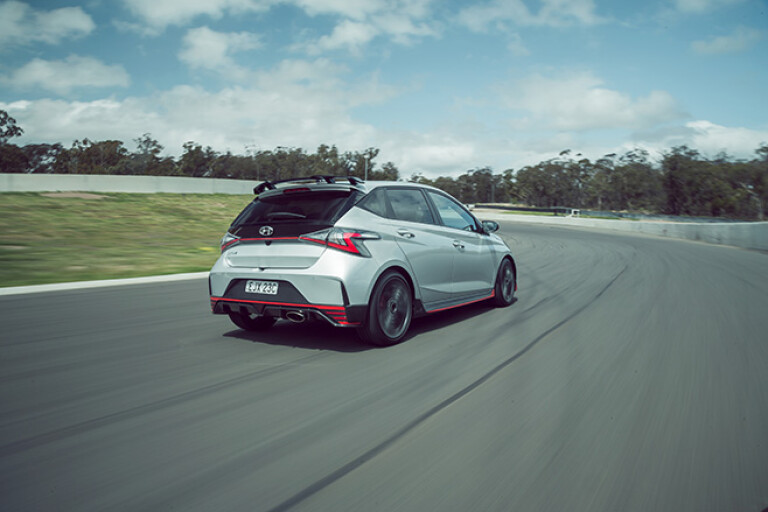
A sighting lap of the 2.2km confines of the undulating 20-year-old Wakefield track is instantly illuminating – the i20 N is a fun little thing.
The steering isn’t quite as quick in rack as we were expecting – so, the dynamic opposite of the lightning front end in the Fiesta ST, then – but the reward is tactility, support and presence in equal measure, with linear weighting right through the motion.
The rear follows faithfully, too, imparting stability of something one size larger (a nod to its 2580mm wheelbase; some 90mm longer than a Fiesta). Its grippy tyre spec helps here, too.
The 1.6-litre engine is linear and strong-ish, too; while it feels as if the i20 N could handle more, the amount it has to work with is part of the reason it all feels so nice out of the box.
It’s far from sonorous in the engine note department, but the orchestrated overrun crackles – while not as overt as the i30 N’s – are still a delight.
After just one lap, it’s fair to say I’m pretty smitten. Every element of the i20 N imparts a sense of joy I just wasn’t expecting.
There’s character, ability, grip, turn, squirt… all working together in a seamless, resolved way that belies the car’s size and specs.
It’s not all choirs and balloons, of course. My main criticism is a third gear that is ssssoooo loooong that it allows the engine to fall out of its torque band unless you’re pretty abusive with your shift pattern, while the shifter itself feels a bit short.
Koster said second gear was deliberately geared to 100km/h, resulting in a taller third gear as well.
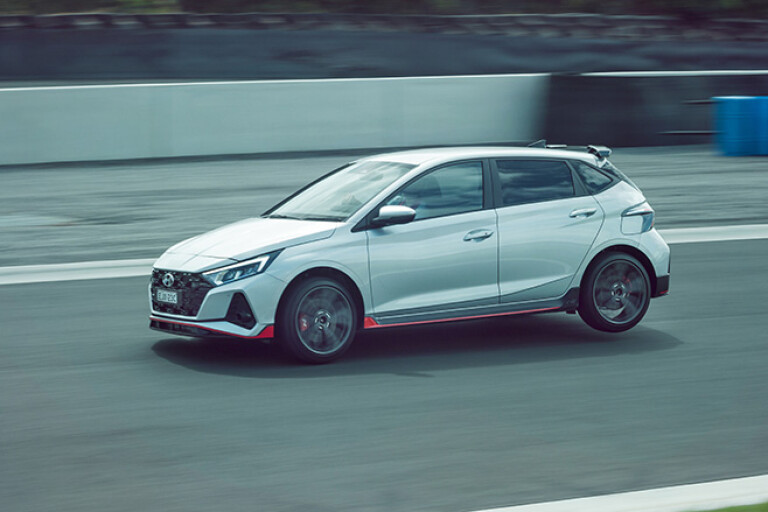
That long third gear also exposes a bit of a hole at the bottom of the rev range that I wondered could ever be filled with hybrid assistance.
“Big question,” Koster says, his grin filling the video chat window. “Overall, I think electrification in some way, you will never get it wrong. So, there is a need to do something this direction.
"How and when I cannot tell you because I don’t have my Men in Black memory ray with me, and I cannot kill you because you’re in Australia!”
My laps are limited, so I wind up the wick on the second tour. This poor prototype has been leant on all day but, as I’ve found previously with the i30 N, these cars are built to take this kind of abuse.
There’s a suppleness and a forgiving nature to the i20 N that flatters the rookie but entertains the more experienced, and it’s all I can do to wind out of it for a lap at pedestrian pace.
I’m glad I did – the damper tune is, to my butt at least, right on the money for everyday work.
It’s with a sense of regret that I peel into the pit lane to hand back the i20 N. I could have lapped that thing until the tyres fell off, I reckon. For this car to make such an impression in just 10 kilometres speaks volumes to me.
“It’s not about being the fastest one (which doesn’t mean that we aren’t trying to be fast!),” Koster muses. “But it’s not about being a tenth of a second faster from zero to 100 or whatever. It’s about having fun.”
I’m very keen to get back in the i20 N for a proper lean on it, but even after this briefest of dalliances, its cheap and cheerful nature has me already excited about a revisit – ideally for the full meal, rather than just a tasty appetiser.
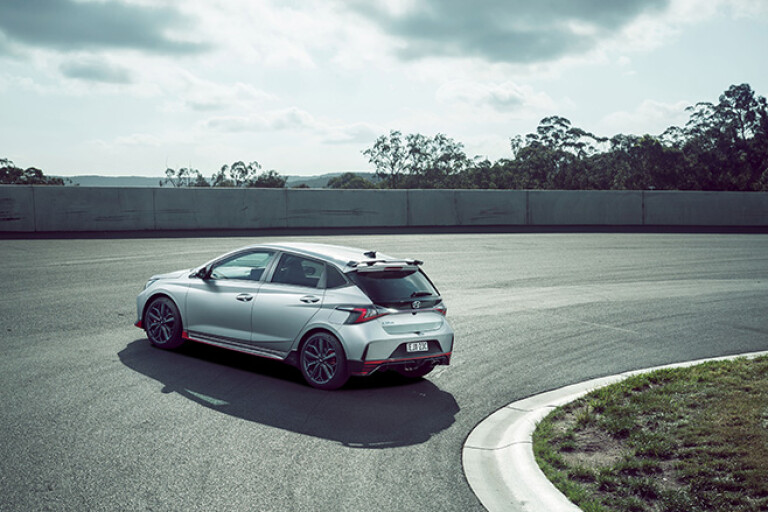
Gamma Raise: The i20 N’s 1.6-litre turbo engine
Popular across the Hyundai universe, the i20 N’s inline-4 – known as the TGDI Gamma II – scores extra weaponry you won’t see in, say, an i30 N-Line, like a high-performance water pump for its intercooler circuit.
“At least in Europe, this is the first time this engine has been introduced,” says Koster. “This is really a state-of-the-art engine.” Compare the 1190kg i20 N’s 150kW/275Nm with the two cars it’ll compete with, too – Ford’s Fiesta ST (147kW/290Nm, 1262kg) and the VW Polo GTI (147kW/320Nm, 1285kg) – and it’ll be an interesting fight.
Three Hyundai i20 N things you should know
1. Brakes and tyres
Not for the i20 N are fancy one-piece Brembos; instead, it uses sliding calipers from a larger Hyundai (we’re guessing Tucson) and rotors a full 42mm bigger in diameter than those on Fiesta ST.
The P-Zeros, too, are coded by Pirelli so they can be easily sourced once they wear out.
2. Chassis kinematics
This is no shopping trolley chassis any more, says head engineer Koster. “We changed the front axle kinematics with a new [hub] knuckle to match the high performance requirements. We did a new rear CTBA [couple torsion beam axle], too, and that was no small investment...”

3. No auto
“There will be no dual-clutch version,” confirms Koster. “In the B-segment, the manual is just the way to go. For those customers who think they need a dual clutch, we have the right product in the C-segment.”
That would be i30 N which just scored an eight-speed wet DCT.
Hyundai i20 N specs
Engine 1591cc 4cyl, DOHC, 16v, turbo
Max Power 150kW @ 5500-6000rpm
Max Torque 275Nm @ 1750-4500rpm
Dimensions (L/W/H) 4075/1750/1440mm
Wheelbase 2580mm
Transmission 6-speed manual
Weight 1190kg
0-100km/h6.7sec (claimed)
Economy9.0L/100km (estimate)
Price $32,500 (estimate)
On sale H1/2021
COMMENTS